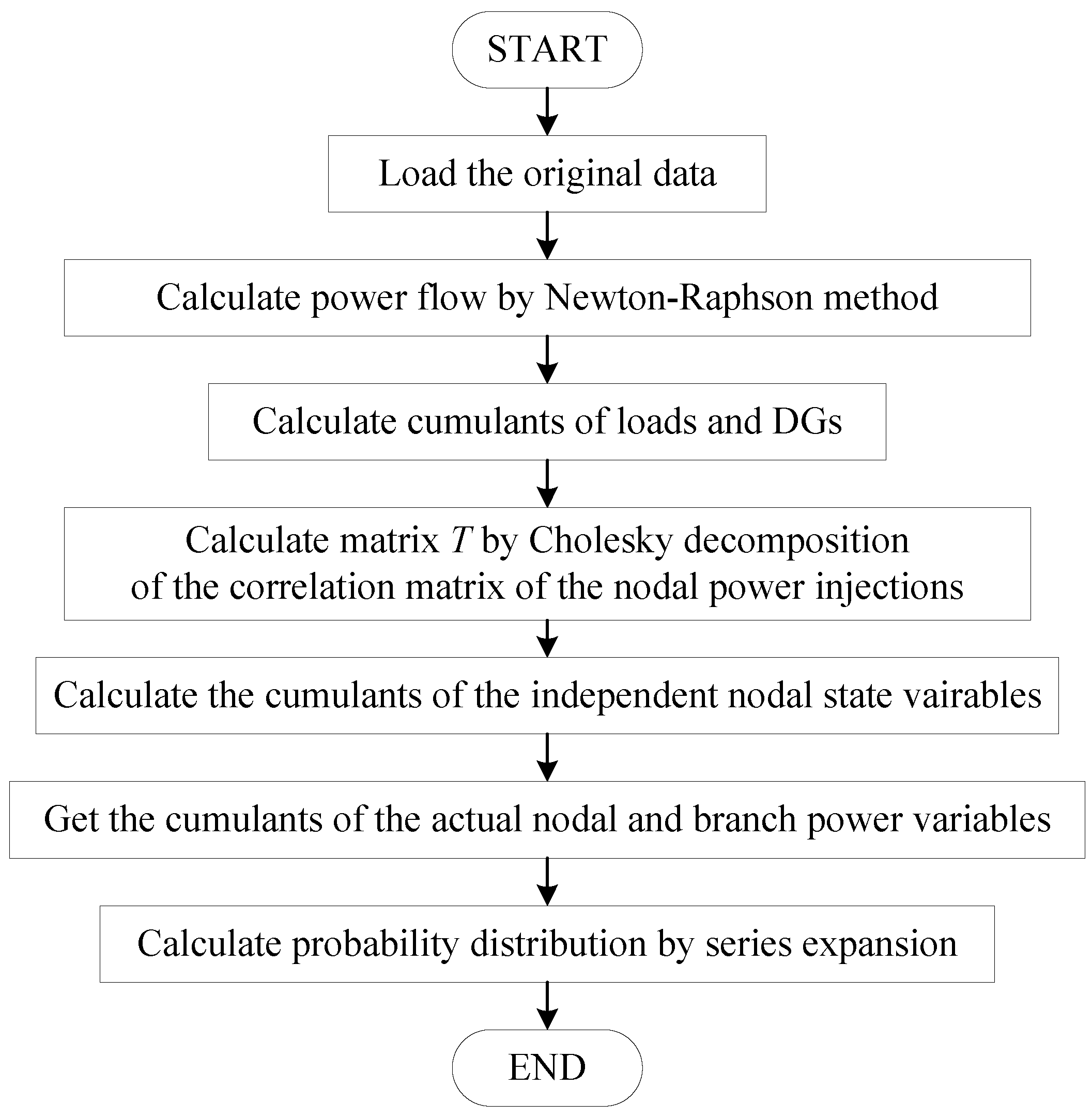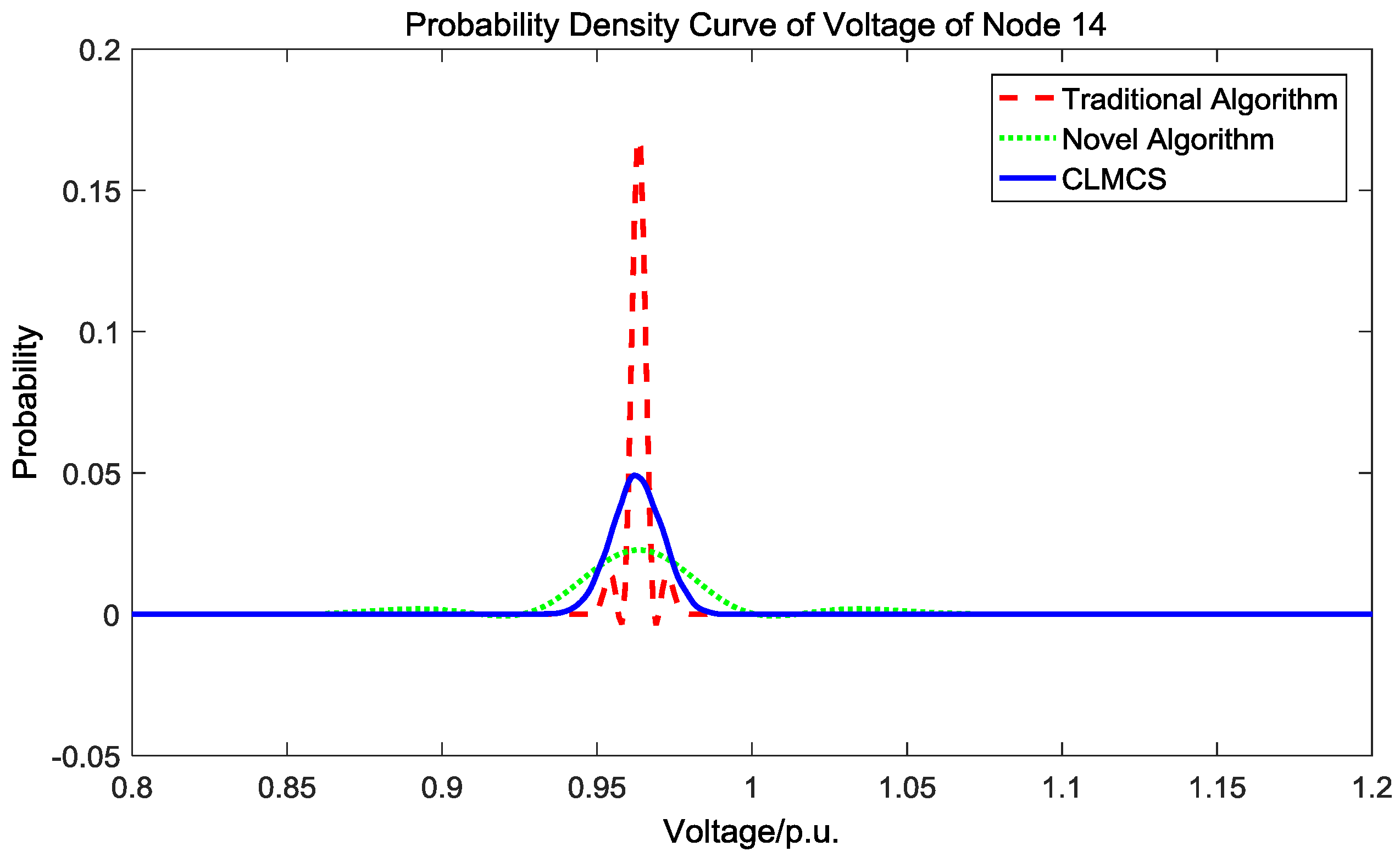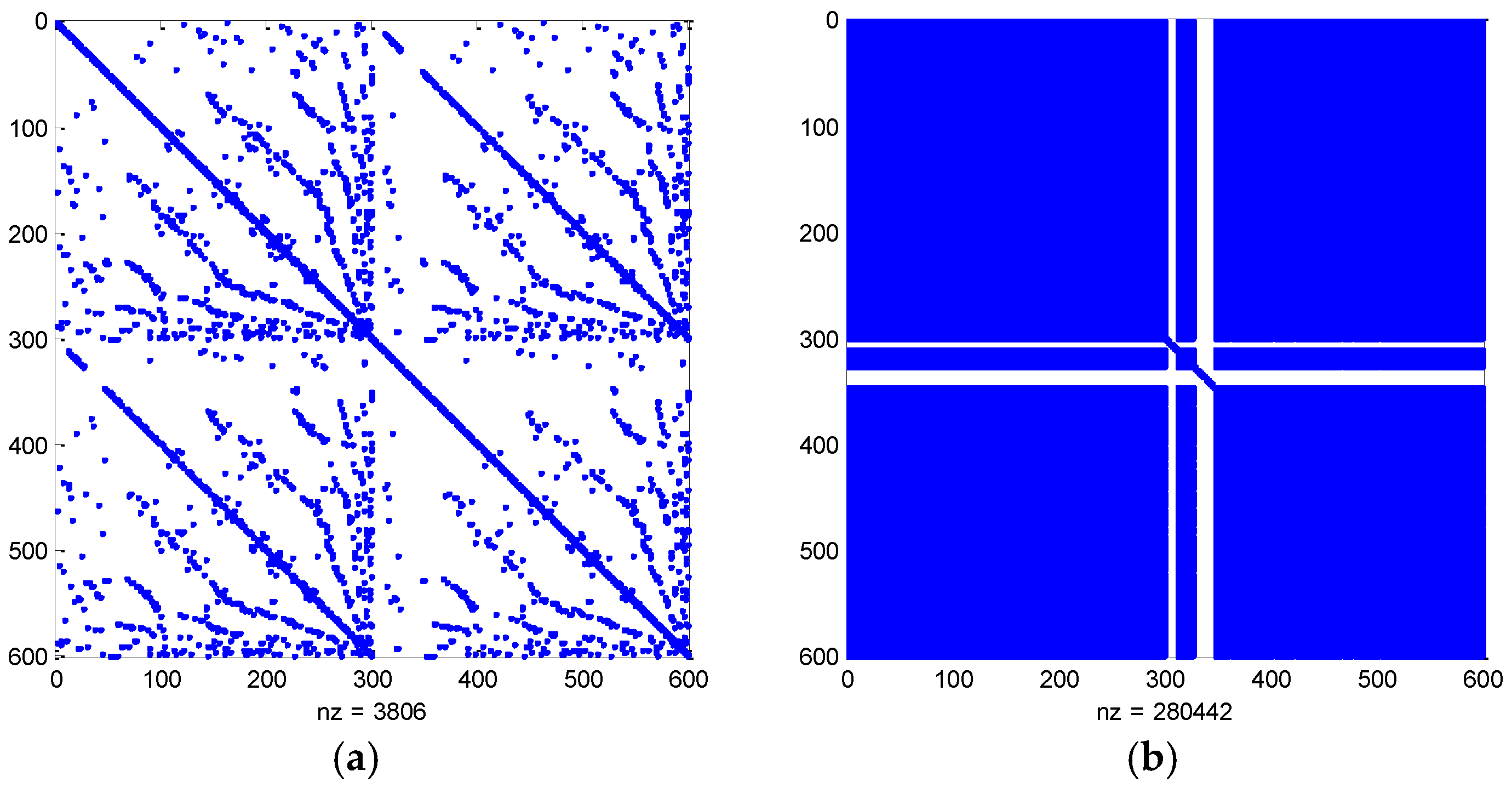A Parallel Probabilistic Load Flow Method Considering Nodal Correlations
Abstract
:1. Introduction
2. Theory of Probabilistic Load Flow
2.1. Basics of Probability
- (a)
- The cumulants meet the additivity condition. If , and , are independent of each other, the following expression can be derived:where , , are separately the -th order culumants of , , .
- (b)
- The cumulants meet the homogeneity condition. If , the -th order cumulants of will be equal to the product of the -th order cumulants of and :
2.2. Probabilistic Modeling of Power System Uncertainties
2.3. Theory of Traditional Probabilistic Load Flow
2.4. Flowchart of Traditional Probabilistic Load Flow
3. The Novel Probabilistic Load Flow Algorithm Considering Nodal Correlations
3.1. Correlations between Random Variables
3.2. Novel Probabilistic Load Flow Algorithm Considering Nodal Correlations
3.3. Flowchart of the Novel Probabilistic Load Flow Algorithm
4. Further Improvement of the Novel Probabilistic Load Flow Based on Parallel Computing
4.1. Basics of Parallel Computing
4.2. Parallel Characteristics Analysis for Probabilistic Load Flow Algorithms
4.3. Flowchart of the Improved Probabilistic Load Flow Algorithm Based on Parallel Computing
5. Case Studies
5.1. System Descriptions
5.2. Accuracy of Novel Probabilistic Load Flow Algorithm
5.3. Computational Efficiency of Novel Probabilistic Load Flow Algorithm Considering Nodal Correlations
5.4. Parallel Performance of Novel Probabilistic Load Flow Algorithm
6. Conclusions
Acknowledgments
Author Contributions
Conflicts of Interest
References
- Wang, X.F.; Song, Y.; Irving, M. Modern Power Systems Analysis; Springer: New York, NY, USA, 2008. [Google Scholar]
- Borkowska, B. Probabilistic load flow. IEEE Trans. Power Appar. Syst. 1974, PAS-93, 752–759. [Google Scholar] [CrossRef]
- Schilling, M.T.; Leite da Silva, A.; Billington, R.; El-Kady, M. Bibliography on power system probabilistic analysis (1962–1988). IEEE Trans. Power Syst. 1990, 5, 1–11. [Google Scholar] [CrossRef]
- Da Silva, A.L.; Arienti, V. Probabilistic load flow by a multilinear simulation algorithm. IEE Proc. C Gener. Transm. Distrib. 1990, 137, 276–282. [Google Scholar] [CrossRef]
- Usaola, J. Probabilistic load flow with wind production uncertainty using cumulants and Cornish-fisher expansion. Int. J. Electr. Power Energy Syst. 2009, 31, 474–481. [Google Scholar] [CrossRef]
- Morales, J.M.; Perez-Ruiz, J. Point estimate schemes to solve the probabilistic power flow. IEEE Trans. Power Syst. 2007, 22, 1594–1601. [Google Scholar] [CrossRef]
- Sun, Y.; Mao, R.; Li, Z.; Tian, W. Constant Jacobian matrix-based stochastic Galerkin method for probabilistic load flow. Energies 2016, 9, 153. [Google Scholar] [CrossRef]
- Zhang, P.; Lee, S.T. Probabilistic load flow computation using the method of combined Cumulants and Gram-Charlier expansion. IEEE Trans. Power Syst. 2004, 19, 676–682. [Google Scholar] [CrossRef]
- Hernández, J.; Ruiz-Rodriguez, F.; Jurado, F. Technical impact of photovoltaic-distributed generation on radial distribution systems: Stochastic simulations for a feeder in Spain. Int. J. Electr. Power Energy Syst. 2013, 50, 25–32. [Google Scholar] [CrossRef]
- Sun, C.; Bie, Z.; Xie, M.; Jiang, J. Fuzzy copula model for wind speed correlation and its application in wind curtailment evaluation. Renew. Energy 2016, 93, 68–76. [Google Scholar] [CrossRef]
- Usaola, J. Probabilistic load flow with correlated wind power injections. Electr. Power Syst. Res. 2010, 80, 528–536. [Google Scholar] [CrossRef]
- Shi, D.; Cai, D.; Chen, J.; Duan, X.; Huijie, L.I.; Yao, M. Probabilistic load flow calculation based on Cumulant method considering correlation between input variables. Chin. Soc. Electr. Eng. 2012, 32, 104–113. [Google Scholar]
- Fan, M.; Vittal, V.; Heydt, G.T.; Ayyanar, R. Probabilistic power flow studies for transmission systems with photovoltaic generation using Cumulants. IEEE Trans. Power Syst. 2012, 27, 2251–2261. [Google Scholar] [CrossRef]
- Morales, J.; Baringo, L.; Conejo, A.; Mínguez, R. Probabilistic power flow with correlated wind sources. IET Gener. Transm. Distrib. 2010, 4, 641–651. [Google Scholar] [CrossRef]
- Yu, H.; Chung, C.Y.; Wong, K.P.; Lee, H.W.; Zhang, J.H. Probabilistic load flow evaluation with hybrid latin hypercube sampling and cholesky decomposition. IEEE Trans. Power Syst. 2009, 24, 661–667. [Google Scholar] [CrossRef]
- Villanueva, D.; Feijóo, A.E.; Pazos, J.L. An analytical method to solve the probabilistic load flow considering load demand correlation using the DC load flow. Electr. Power Syst. Res. 2014, 110, 1–8. [Google Scholar] [CrossRef]
- Barnes, G.H.; Brown, R.M.; Kato, M.; Kuck, D.J.; Slotnick, D.L.; Stokes, R.A. The ILLIAC IV computer. IEEE Trans. Comput. 1968, C-17, 746–757. [Google Scholar] [CrossRef]
- Torralba, A.; Gomez, A.; Franquelo, L.G. Three methods for the parallel solution of a large, sparse system of linear equations by multiprocessors. Int. J. Energy Syst. 1992, 12, 1–5. [Google Scholar]
- Lau, K.; Tylavsky, D.J.; Bose, A. Coarse grain scheduling in parallel triangular factorization and solution of power system matrices. IEEE Trans. Power Syst. 1991, 6, 708–714. [Google Scholar] [CrossRef]
- Alvarado, F.L. Parallel solution of transient problems by trapezoidal integration. IEEE Trans. Power Appar. Syst. 1979, PAS-98, 1080–1090. [Google Scholar] [CrossRef]
- Chai, J.S.; Bose, A. Bottlenecks in parallel algorithms for power system stability analysis. IEEE Trans. Power Syst. 1993, 8, 9–15. [Google Scholar] [CrossRef]
- Fang, W.; Ngan, H.W. A robust load flow technique for use in power systems with unified power flow controllers. Electr. Power Syst. Res. 2000, 53, 181–186. [Google Scholar] [CrossRef]
- Abouzahr, I.; Ramakumar, R. An approach to assess the performance of utility-interactive wind electric conversion systems. IEEE Trans. Energy Convers. 1991, 6, 627–638. [Google Scholar] [CrossRef]
- Liu, J.; Fang, W.; Yang, Y.; Yang, C.; Lei, S.; Fu, S. Increasing wind power penetration level based on hybrid wind and Photovoltaic generation. In Proceedings of the TENCON 2013—2013 IEEE Region 10 Conference (31194), Xi’an, China, 22–25 October 2013.
- Karaki, S.; Chedid, R.; Ramadan, R. Probabilistic performance assessment of autonomous solar-wind energy conversion systems. IEEE Trans. Energy Convers. 1999, 14, 766–772. [Google Scholar] [CrossRef]
- Liu, J.; Fang, W.; Zhang, X.; Yang, C. An improved photovoltaic power forecasting model with the assistance of aerosol index data. IEEE Trans. Sustain. Energy 2015, 6, 434–442. [Google Scholar] [CrossRef]
- Cai, D.; Chen, J.; Shi, D.; Duan, X.; Li, H.; Yao, M. Enhancements to the cumulant method for probabilistic load flow studies. In Proceedings of the 2012 IEEE Power and Energy Society General Meeting, San Diego, CA, USA, 22–26 July 2012.
- Ruiz-Rodriguez, F.; Hernandez, J.; Jurado, F. Probabilistic load flow for photovoltaic distributed generation using the Cornish-Fisher expansion. Electr. Power Syst. Res. 2012, 89, 129–138. [Google Scholar] [CrossRef]
- Chen, Y.; Wen, J.; Cheng, S. Probabilistic load flow analysis considering dependencies among input random variables. Proc. CSEE 2011, 31, 80–87. [Google Scholar]
- Wang, K.; Tse, C.; Tsang, K. Algorithm for power system dynamic stability studies taking account of the variation of load power. Electr. Power Syst. Res. 1998, 46, 221–227. [Google Scholar] [CrossRef]
- Chen, G.-L.; Sun, G.-Z.; Zhang, Y.-Q.; Mo, Z.-Y. Study on parallel computing. J. Comput. Sci. Technol. 2006, 21, 665–673. [Google Scholar] [CrossRef]
- Amdahl, G.M. Validity of the single processor approach to achieving large scale computing capabilities. In Proceedings of the Spring Joint Computer Conference, Atlantic City, NJ, USA, 18–20 April 1967; pp. 483–485.
- Gustafson, J.L. Reevaluating Amdahl’s law. Commun. ACM 1988, 31, 532–533. [Google Scholar] [CrossRef]
- Duan, C.; Jiang, L.; Fang, W.; Liu, J. Moment-SOS approach to interval power flow. IEEE Trans. Power Syst. 2016. [Google Scholar] [CrossRef]
- Niu, S.; Wang, J.; Huo, C.; Liu, J. An novel power flow calculation model with the elimination of interconnecting nodes. In Proceedings of the First International Conference on Information Sciences, Machinery, Materials and Energy, Chongqing, China, 11–13 April 2015.
- Ruiz-Rodriguez, F.; Hernández, J.; Jurado, F. Voltage unbalance assessment in secondary radial distribution networks with single-phase photovoltaic systems. Int. J. Electr. Power Energy Syst. 2015, 64, 646–654. [Google Scholar] [CrossRef]






| Test Systems | Traditional Algorithm (s) | Novel PLF Algorithm (s) | Computational Efficiency Improvement (%) |
|---|---|---|---|
| IEEE-300 | 6.373 | 5.634 | 13.1 |
| C703 | 14.109 | 10.479 | 34.6 |
| N1047 | 22.075 | 16.100 | 37.1 |
| Test Systems | Traditional Algorithm (s) | Novel PLF Algorithm (s) | Computational Efficiency Improvement (%) |
|---|---|---|---|
| IEEE-300 | 0.428 | 0.085 | 403.5 |
| C703 | 2.244 | 0.493 | 355.2 |
| N1047 | 5.300 | 1.185 | 347.3 |
| Test Systems | Serial Computation Time (s) | Parallel Computation Time (s) | Parallel Speedup Ratio | Parallel Efficiency (%) |
|---|---|---|---|---|
| IEEE-300 | 6.373 | 4.545 | 1.402 | 70.1 |
| C703 | 14.109 | 9.075 | 1.555 | 77.8 |
| N1047 | 22.075 | 15.415 | 1.432 | 71.6 |
| Test Systems | Serial Computation Time (s) | Parallel Computation Time (s) | Parallel Speedup Ratio | Parallel Efficiency (%) |
|---|---|---|---|---|
| IEEE-300 | 5.634 | 3.906 | 1.442 | 72.1 |
| C703 | 10.479 | 6.361 | 1.647 | 82.4 |
| N1047 | 16.100 | 9.900 | 1.626 | 81.3 |
© 2016 by the authors; licensee MDPI, Basel, Switzerland. This article is an open access article distributed under the terms and conditions of the Creative Commons Attribution (CC-BY) license (http://creativecommons.org/licenses/by/4.0/).
Share and Cite
Liu, J.; Hao, X.; Cheng, P.; Fang, W.; Niu, S. A Parallel Probabilistic Load Flow Method Considering Nodal Correlations. Energies 2016, 9, 1041. https://doi.org/10.3390/en9121041
Liu J, Hao X, Cheng P, Fang W, Niu S. A Parallel Probabilistic Load Flow Method Considering Nodal Correlations. Energies. 2016; 9(12):1041. https://doi.org/10.3390/en9121041
Chicago/Turabian StyleLiu, Jun, Xudong Hao, Peifen Cheng, Wanliang Fang, and Shuanbao Niu. 2016. "A Parallel Probabilistic Load Flow Method Considering Nodal Correlations" Energies 9, no. 12: 1041. https://doi.org/10.3390/en9121041





